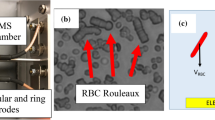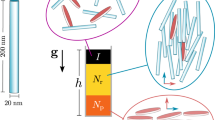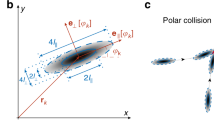Abstract
Smith and Chance1 have reported the behaviour of coacervates in an alternating electric field. Earlier, Furedi and Ohad2 observed similar behaviour by live red blood cells in isotonic sucrose suspension of enthrocytes in a high frequency electric field. These microscopic particles show a characteristic elongation at right angles to the electric field followed by a slow rotation of the deformed particle until its longer axis aligns itself parallel to the electric field in a final stable shape. A physical attempt is made below to explain the mechanism of this behaviour.
This is a preview of subscription content, access via your institution
Access options
Subscribe to this journal
Receive 51 print issues and online access
$199.00 per year
only $3.90 per issue
Buy this article
- Purchase on Springer Link
- Instant access to full article PDF
Prices may be subject to local taxes which are calculated during checkout
Similar content being viewed by others
References
Smith, A. E., and Chance, A. C., Nature, 209, 74 (1966).
Furedi, A. A., and Ohad, I., Biochim. Biophys. Acta, 79, 1 (1964).
Jefemenco, O. D., Electricity and Magnetism, 258 (Appleton-Century-Crofts, 1966).
Stratton, J. C., Electromagnetic Theory, 142 (McGraw Hill, 1941).
Anderson, J. C., Dielectrics, ch. 4, 49 (Chapman and Hall, Ltd., 1964).
Author information
Authors and Affiliations
Rights and permissions
About this article
Cite this article
SHARMA, R. Mechanism of Characteristic Behaviour of Cells in an Alternating Electric Field. Nature 214, 83–84 (1967). https://doi.org/10.1038/214083a0
Issue Date:
DOI: https://doi.org/10.1038/214083a0
Comments
By submitting a comment you agree to abide by our Terms and Community Guidelines. If you find something abusive or that does not comply with our terms or guidelines please flag it as inappropriate.



